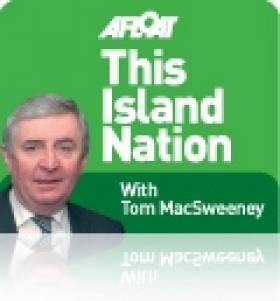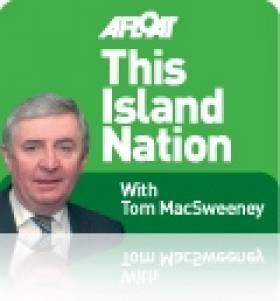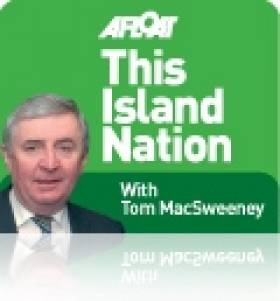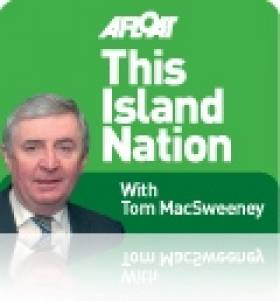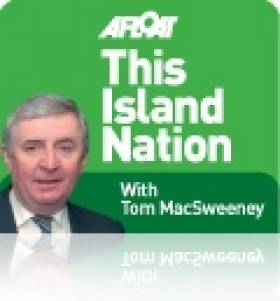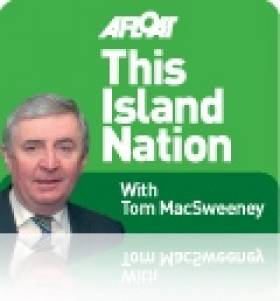Displaying items by tag: Island Nation
Lifeboat Design, Foam in Aberdeen, and International Maritime Stories
KEEPING A LIFEBOAT UNDER WRAPS
Keeping a lifeboat design under wraps is some achievement, but that's what an Irishman did with the design for the first RNLI lifeboat to be named after an Irish river. In fact, at the age of 24 he designed the hull form in his spare time!
Four years after his original design, the Shannon class was introduced to public view this week at RNLI headquarters.
Peter Eyre, from Derry, could take justifiable pride because he is an RNLI Naval Architect.
'I kept the design under wraps in the early stages. After a while my boss could see I was working on something and encouraged me to continue. My job was to find the design by working with other naval architects, not to design it. I was the youngest in the team and before long I had designed the new lifeboat hull.
I'm chuffed it was named after an Irish river and the strong connection the boat now has with Ireland. I think the moment it first goes out on a service will be the high point of my career. It's a great legacy to be a part of. When the first life is saved I think that's when it will really hit home.'
Peter has a strong commitment to the RNLI, ever since he was just 14-years-old and the family's 30ft. cruiser racer yacht was dismasted in rough seas and Force 7 winds.
"We were escorted back to shore by the volunteer lifeboat crew. We were so relieved," he recalls.
This is the first time that the RNLI has named a class of lifeboat after an Irish rive.
"It is very fitting considering that Peter has been so fundamental in its design," said Owen Medland, RNLI Training Divisional Inspector for Ireland. "All of the crews who have tested the new lifeboat have been thrilled with its speed, manoeuvrability and the improved crew safety features. We don't know yet which Irish lifeboat stations will receive a Shannon class lifeboat, but the Shannon is designed to replace the majority of Mersey and some Tyne class lifeboats. We look forward to seeing the Shannon here in the near future.'
UK stations will be the first to get the new boat for which the RNLI has launched a €6m. fundraising campaign across the UK and Ireland.
• To make a donation visit: www.rnli.org/newlifeboatappeal
NEW FACE OF ABERDEEN

The amount of foam which swept into Aberdeen in Scotland from the gales that hit the UK and caused a lot of flooding during the week was astonishing.
As the photograph here shows, it looks like the area close to the seashore was covered in snow.
Capt.Rowan MacSweeney, my son, is serving on offshore oil rig supply work at present and told me:
"Monday night was a lively night about these parts. We were 4.5nm out from Aberdeen breakwaters because the port closed. Top gust on our anenometer 70 knots and we got swells of 13metres in the bay. Check out the photo one of the lads I know from another boat took the morning after of the foam created by the storm. Pretty unusual."
Indeed it is.
RULING ENDS 'DARK AGES'
{youtube}MbjC9SMKClE{/youtube}
The tanker Exxon Valdez which became notorious after spilling 750,000 barrels of oil into Prince William Sound in Alaska on March 24, 1989, is to be broken-up on Alang Beach in India following assurances given to India's highest court that it would not contain hazardous substances. This was needed after the Court made a ruling which environmentalists have hailed as ending the 'dark ages' of breaking up ships containing hazardous materials on beaches. There have been increasing protests about this practice because of the health, safety and environmental risks involved, particularly for low-paid workers without protection equipment. The Court ruled that vessels sent for shipbreaking will be subject to international rules based on the Basel Convention about hazardous wastes, meaning that shipowners will in future have to remove these materials before the ships are approved for breaking-up on Indian beaches.
FIRST NORWEGIAN CRUISE

The first cruise direct from Cork to Norway has been announced. Lee Travel and Royal Caribbean International will run two 12-day cruises on June 3 and September 9 next year aboard the Independence of the Seas departing from Cork Port's cruise terminal at Cobh. There will be a capacity for 200 passengers to join in Cork Harbour, according to Lee Travel with prices from €1,699 per person, based on 2 adults sharing an inside stateroom. Fly/Cruise price includes flights back to Dublin/Cork. The Norwegian cruises will take in fjords, glacial inlets, castles, the Norwegian countryside and Oslo.
Declan O Connell, Managing Director of Lee Travel, said there is a demand for such a service from Cork. "We are confident that these cruises will be popular and that Royal Caribbean will sail more ships out of Cobh for many years to come."
GAS FERRIES
Norway is also to the fore in another cruise ship development. The first cruise ferries in the world to be powered by natural gas are under construction in a Bergen shipyard for the Norwegian shipping company, Fjord Line. They will be 170-metres long, powered by Rolls Royce LNG-based engines. The company says they will be the most environmentally-friendly cruise ships on the seas, the first to begin sailing next May out of Bergen in Norway and the second a few months later.
WORK-RELATED DROWNINGS
The Irish Water Safety Association has recorded 22 work-related drownings in the Republic in the past five years of which 17 were in fishing, 1 while transporting freight over water, 1 each in quarrying and construction and 2 in agriculture. The figures were released this week, coinciding with the National Ploughing Championships and following the tragic Northern Ireland drownings in the farm slurry tank, as a reminder that safety is needed at all times. The Association has also pointed out that children are naturally curious about water: "Each year too many young children are involved in preventable aquatic accidents - forty children have drowned in the last ten years."
FIRST MAN TO WALK ON THE MOON BURIED AT SEA
The first man to walk on the moon has been buried at sea. NASA said Neil Armstrong's cremated remains were buried in the Atlantic Ocean during a ceremony aboard the USS Philippine Sea. The space agency didn't give the location of the ceremony. The ship's homeport is Mayport, Florida. Neil
Armstrong was a Navy fighter pilot before joining the space programme. He died in Ohio in August at the age of 82. His burial followed at sea followed a memorial service in Washington.
RUSSIAN SPECIAL
The Russian Navy is to build a new type of search-and-rescue ship which will be launched in 2014. It will have submersible rescue vessels aboard. This is because of the number of Russian submarines which have got into difficulties in past years.
CHINESE FIRST
China's first aircraft carrier has entered service. The 300m (990ft) Liaoning - named after the province where it was refitted - is a refurbished Soviet ship purchased from Ukraine. the carrier has no operational aircraft and will be used for training. The Chinese Government said the vessel, which has undergone extensive sea trials, will increase its capacity to defend State interests.
TANKER DESTROYED COMMANDER
The Commander of a U.S. Navy destroyer was removed from command after his vessel was involved in a collision. The USS Porter was operating near the Straits of Hormuz when struck on its starboard side by the 300,000-tonne tanker Otowasan. Nobody was hurt in the incident .The tanker suffered only superficial damage, but the destroyer was severely damaged according to reports and sailed to the United Arab Emirates for repairs. The destroyer's Commander, Martin Arriola, was removed from command there and replaced.
MAIDEN GROUNDING
A cargo ship has ran aground on its maiden voyage from Southampton to the Channel Islands. The 295ft. £8.8m Huelin Renouf Dispatch hit an isolated rock one and a half miles south-west of Alderney and issued a distress cal, responded to by the RNLI Roy Barker One which was on the scene within 15 minutes. Damage to the Dispatch was assessed and it was found that water was coming in at the stern. The vessel had a crew of eight. The leak was contained and the 2,500-ton ship was floated off the rock then sailed to Falmouth at half-speed where it went into dry dock.
Email your comments on maritime matters to : [email protected]
Follow Tom for more maritime news and comment on Twitter: @TomMacSweeney
And on Facebook – http://www.facebook.com/THISISLANDNATION
Leading the World in Marine Research
#islandnation –In your maritime 'This Island Nation' column this week. Ireland will lead the world in maritime research ...Will you help to survey the coastline? The Titanic Captain had trouble with his navigation ... Extreme trapezing ... A new cruise opportunity, from Cork to Norway .... Screaming angling reels and more in Rosslare ...
BEAUFORT WILL LEAD WORLD RESEARCH
Work has begun on building the Beaufort Laboratory alongside the National Maritime College in Ringaskiddy, Cork Harbour, a development which will put Ireland in a leadership role in world maritime research. It is fitting that the name of the Irishman who gave the world the Beaufort windscale is attached to a laboratory that will provide a focus for research and commercial opportunities benefiting Ireland.

The Beaufort site

The Coastal and Marine Research Centre attached to UCC has for many years been doing tremendous research work of which this is its latest development with the involvement of the NMC, Cork VEC, the Hydraulics and Maritime Research Centre and the Sustainable Energy Research Group in UCC. The building is being funded by the HEA-PRTLI, Department of Communications, Energy and Natural Resources and Bord Gais and is due to be opened in the Autumn of next year. It will have a capacity for more than 130 researchers to work there and several major international companies have already indicated their interest in using its facilities.
HELP TO WATCH THE COAST
The 25th Coastwatch survey of the Irish coastline is underway and public help is being sought for this eco-audit. The survey includes shore and land use, inflow water quality and the effects on plants and animals, as well as waste, pollution and litter. "Citizen science" is how it has been described by Karen Dubsky who has co-ordinated the survey for many years. She has asked for volunteer support which can be done by downloading survey forms from the Coastwatch website to where results can also be Emailed.
"Volunteers can download the questionnaire and guide notes, choose 500 metres of shore to survey then check that area at low tide and note down the results," she said.
TITANIC CAPTAIN HAD DIFFICULTY IN PASSING NAVIGATION TESTS
The UK National Maritime Museum has released documents about seamen and the examinations they had to take in the years between 1850 and 1927. They show that the Captain of the Titanic originally failed his navigation test.
Capt. Edward John Smith, whose body was not recovered after he went down with the Titanic when it sank in 1912, failed his exams the first time round because he did not have sufficient navigating skills. But he did eventually pass the exam and receive his Masters Certificate in February 1888.
The documents provide a fascinating insight into Merchant Navy life at the turn of the 19th-Century. Effectively, they show the change in life at sea from the previous attitudes towards maritime safety towards the more modern requirements for seafarer training.
"They are a rich source of information for anybody looking to find out more about a seafaring relative or trace the career of a famous captain," says the Museum in releasing a total of 280,000 documents.
EXTREME TRAPEZING CAUSES PROTEST
The 49er skiff European Championships on Lake Garda saw a form of extreme trapezing which caused protests! The Danish crew of helmsman Allan Norregaard, an Olympic bronze medallist, crewed by Anders Thomsen, were protested for a new type of 'trapezing'. Other competitors lodged the protest when the two were seen to both 'trapeze' out of the boat at the same time when Norregaard gave the tiller to Thomsen, who took up the normal trapezing position and steered as well, while Norregarrd the normal helm, climbed onto his shoulders and trapezed out of the boat above him – a dual trapezing technique never seen before in international competitive championship sailing!
Summoned before the International Protest Jury to answer complaints, both claimed there was nothing in the sailing rules against what they described as the 'ultimate trapezing technique.'
The jury agreed!
"It works in stable conditions of 15-20 knots and Lake Garda was perfect to try it," said Norregaard.
Other teams subsequently tried the technique but failed to replicate it! The Class Association is considering whether a rule change is needed!
DIRECT FROM CORK TO NORWAY
Cruising has become very popular but direct opportunities from Ireland have been limited, though they are increasing, with a 'first' to a new destination to be launched next year, direct from Cobh in Cork Harbour to Norway. The Port of Cork Company, Royal Caribbean and the Lee Travel agency are to announce details on Thursday, September 27 of the 12-day Norwegian Fjords Cruise.
INTERNATIONAL ENERGY CONFERENCE FOR DUBLIN
The 4th International Conference and Exhibition on Ocean Energy will be held from October 17 to October 19 in Dublin. Sixty-five international exhibitors are so far booked for the exhibition which will be held in the Dublin Convention Centre. Major speakers are also lined-up for the event.
ROSSLARE MARITIME ENTHUSIASTS
Rosslare Maritime Enthusiasts have taken over the former Tourist Office on the main road from Rosslare Harbour to Kilrane. The group have begun transforming the building into what will be called 'The Rosslare Harbour Maritime Heritage Centre.' The group, formed in 2004, has published two books and a third is nearing completion.
"We have previously held an annual maritime exhibition during the Rosslare Harbour summer festival but have been looking for a suitable permanent home to establish what we believe will be a great addition to the community and County Wexford," they say.
ROSSLARE'S TOP TRIGGER
Also in Rosslare an "Uptide Girl," an English angling writer and a top triggerfish, combined in the boat name, the writer Gordon Thornes and the 2.32kg. triggerfish to become the Inland Fisheries Ireland 'Catch of the Week' during the Rosslare Small Boats festival which proved to be a great success again this year despite challenging weather conditions for the competition.

For the third time in the last four years 'Screaming Reels' from Rosie's Sea Angling Club in Cork won the competition with 24 different species of fish, beating 28 other boats from the UK. Fishing was very good with 30 different species recorded.
Silver Millions, Piracy Hostage Couple & World Cup Sailing Students
In this week's This Island Nation Column, millions in silver to be recovered off Cork, a piracy hostage couple sailing again, five million dollars to recover a schooner and reports about world cup students and an offer to survey whales.
RECOVERING SILVER MILLIONS OFF CORK
A ship engaged in wreck recovery worth millions of pounds sterling docked in Cork Harbour in the past week to change crew, take on fuel and supplies, then sailed again for a location 300 miles off the Irish coast. Odyssey Marine Exploration has so far recovered 48 tonnes of silver, believed to be worth about stg£24 million from the site to where the vessel, the Seabed Worker returned. Lying on the seabed there is the British India Steam Navigation Company's 412-foot steel-hulled cargo ship Gairsoppa which was part of a convoy during World War Two, returning from India to Britain with a cargo of silver ingots and pig iron. In a heavy storm on February 16, 1941 and running low on coal off the coast of Ireland she had to leave the convoy in an attempt to reach Galway for safety. But a German Air Force plane spotted her and directed a U-Boat to attack. The submarine sank her and killed all of the crew except six who got away in a lifeboat and eventually reached Cornwall, but two of those died trying to get ashore.

The wreck of the Gairsoppa
Odyssey is recovering the silver under contract with the UK Department for Transport. The total value is unclear but some estimates put it around stg£120 million, though there is not confirmation of this figure. Odyssey, a USA company, bears the risk of search and recovery and can retain 80% of the net value of what is recovered after expenses. The shipwreck is three miles below the surface and the company has said that the recovery operation is one of the deepest and heaviest attempted. No materials recovered from the shipwreck site were landed during the port call to Cork.
"Making crew change in Ireland instead of the UK allows us to spend additional working days on the site. As the weather conditions tend to become less friendly in the North Atlantic as we get closer to October, every additional day of operations is important," said Mark Gordon, Odyssey President. "The processing of the silver so far delivered remains on schedule with the first portion available for sale this month If silver prices continue to increase, it will significantly boost the value of this project."
HOSTAGE COUPLE SAIL AGAIN
The English coupled held hostage for more than a year by Somali pirates have set sail on the same yacht again – intending to finish the round-the-world trip from which they were captured off the Seychelles in 2009. The release of Paul and Rachel Chandler, from Tunbridge Wells, was arranged in November 2010.after 13 months in captivity. They have restored their 38-foot yacht, Lynn Rival, which was found drifting in the Indian Ocean after their capture. They said their ordeal had not put them off sailing.
DROP IN PIRACY
The number of pirate attacks on shipping off Somalia has fallen sharply in the first half of this year according to the International Maritime Bureau. 177 incidents were reported to the IMB Piracy Reporting Centre in the first six months of this year, compared to 266 in 2011. But IMB Director Captain Pottengal Mukundan said that there was a worrying increase in attacks on shipping in the Gulf of Guinea.

Photo from the EU Naval Force Somalia shows the capture of a suspected pirate boat off Somalia
Six Somalian pirates have been found guilty of hijacking the French vessel Le Ponant in 2008 and sentenced to a total of 24 years in prison by a court in Paris.
DUBLIN-CORK AXIS FOR WORLD CUP
There is a Dublin-Cork axis to Ireland's attempt to win the Student World Sailing Cup in La Rochelle, France, from October 27 to November 3. University College Dublin's sailing team will represent Ireland but the ten-strong team includes three Cork sailors and will be coached by another Cork sailor. The UCD students won the right to represent Ireland at the Student National Championships in Dun Laoghaire in March. The Cork trio continue Southern sailing involvement in the world cup for several years past but the team is composed also of sailors from all over the country including Antrim, Down, Mayo, Sligo, Wexford and Waterford. Team Captain is Cathal Leigh Doyle; Aidan McLavery from Belgooly is Skipper; Isabella Morehead from Rochestown and Ben Fusco from Kinsale are the other two Cork sailors on the team which includes Barry McCartin, David Fitzgerald, Simon Doran, Theo Murphy, Alyson Rumball and Ellen Cahill.
Reigning student world champions are Euromed Arthur Loyd of France. The UCD team will be trained by Cork sailor Nicholas O'Leary, brother of Olympian Peter O'Leary and past Student Yachting World Cup competitors John Downey and Marty O'Leary. Ireland last won the Cup in 2008, another Cork triumph.
SEEKING WHALE VOLUNTEERS
The Irish Whale and Dolphin Group is looking for volunteers for surveying aboard their Celtic Mist "who have cetacean survey experience (land or sea based) and who have or are prepared to obtain an ENG11 Marine Medical certificate and an STCW95 Sea Survival Certificate," the Group says. Volunteers will have to pay their own expenses to join the vessel and obtain the certificates. Accommodation and meals will be provided free-of-charge on board. Surveys will typically last for 2-3 weeks.
"While we appreciate that participation will involve a cost to volunteers, it will also provide an excellent opportunity for budding cetacean biologists and more seasoned surveyors to gain experience in offshore cetacean surveys," the IWDG says. The Group will provide information and guidance on survey techniques and equipment for data collection.
• If you are interested email [email protected]
AMUNDSEN SCHOONER TO SAIL HOME

A Norwegian group is hoping to raise over five million dollars to raise the 200-tonne schooner sailed by legendary Norwegian explorer Roald Amundsen and return it to Norway. The Maud has lain partially submerged in Cambridge Bay in Canada since sinking in 1930.
FIRST FOR DINGLE
The first Maritime Heritage Weekend in Dingle, Co.Kerry, will be held during the October Bank Holiday Weekend October 27-29. It will commemorate Michael Long and his contribution to marine biology. Born in 1889, he died in 1980 and was a publican in Dingle (John Benny's Pub) who took a great interest in the flora and fauna of the area and all things related to the marine. "He catalogued many specimens brought to his premises and encouraged many others to take an interest in their surroundings on land and at sea and we are delighted to honour him at this event," say the organisers.
The Future of Shipping Fuels, Ireland's last Engineless Sailing Schooner & Lots More
#thisislandnation – The future of shipping fuels, Ireland's last engineless sailing schooner, galley slaves in Russia, locating the newest lifeboats and GPS disruption all in This Island Nation this week.
A FUTURE IN ALGAE
The United States Navy uses 80,000 barrels of oil a day. The total fuel consumption of world shipping is not known, but several shipping lines have introduced 'slow steaming' to reduce oil usage because of increasing costs. Maersk, one of the world's biggest shipping companies and the US Navy have been jointly exploring the possibility of developing 'green fuels'. Maersk has 1,300 vessels in its fleet. This year the Maersk Kalmar, a 300 metre-long container vessel completed a 6,500 nautical-mile voyage from Germany to India burning 30 tonnes of a fuel developed from algae in an its auxiliary engines under test by engineers. Fuel properties were similar to marine gas oil according to Maersk engineers carrying out experiments on board.
Two years ago the US Navy tested its first algae-based fuel and has been engaged in research for several years. In the UK researchers at the University of Bath have been experimenting on the commercial production of biodiesel from algae. Maersk, a Danish company, has been given a grant of 112 million Kroner by the Danish National Advanced Technology Foundation for continuing research into the production of bio-based fuels for the global shipping industry.
IRELAND'S LAST SAILING SCHOONER
The last sailing schooner to trade in Irish waters was the Brooklands which operated without an engine and was a familiar sight in Cork Harbour as she emerged from her home port in the north-eastern corner of the harbour, heading for the open sea. The Creenan family owned Brooklands and sailed her out of Ballinacurra which closed as a port for commercial operations in the early 60s. Brooklands and the Creenans will never be forgotten in the maritime annals of Cork Harbour.
She was originally known as the Susan Vittery and traded along the Irish South coast. At the age of 43 John Creenan of Ballinacurra became her Master. In July of 1920 her name was changed to Brooklands. She was bought by John Creenan for £1,300 in the currency of the time and noted as a three-masted double topsail schooner, capable of carrying 226 tons of cargo.

Richard Scott's new book on the last of the Western Sea Traders
"Captain John liked her and reckoned on making her pay, even without an engine," writes Richard Scott in a new book which was launched in Creenan's family pub in Ballinacurra that was packed with a big attendance from all over the country for the occasion. "Irish Sea Schooner Twilight" is the story of the Western Seas Traders and their last years. These were the vessels which saw the end of sailing traders, as steam and engine power replaced them. They traded coastwise around the Bristol Channel, some across to France, mostly between Ireland and Britain and began to disappear from the seas around the late 50s. Life was tough and dangerous for the seafarers who sailed these vessels.
Dick Scott shipped aboard Brooklands and was the man who wrote the definitive book about the Galway Hookers. He died at the age of 81, so this new book for which he had carried out meticulous research over very many years is also a posthumous tribute to a great marine writer.
He recalls sailing the ship up to Penrose Quay in Cork City to discharge cargo: "Christie knew his vessel well and every detail of the narrows past Fort Camden and Carlisle. We were on the living deck of a remarkable schooner that had first sailed these same waters over ninety years earlier. After discharging cargo the Skipper of a steam collier offered Christie a tow downriver. Off Whitepoint we heaved in our warp as our friends on the collier blew farewell on their ship's hooter and we were on our own, sailing past Cobh, surprising a fleet of yachts as they gave way for the passage of this great sailing vessel, Christie at the wheel, calmly taking the Brooklands towards Ballinacurra where we were to load silica clay for transport to Dublin.'
The days of being without an engine meant that, without a favourable wind, they had to anchor for the night before they could get to Ballinacurra!
"Off the north east corner of Great Island we rounded up at the Crab Hole and dropped anchor for the night. Next day we took assistance from a small motorboat to work the tide two miles up the Ballinacurra River narrows to our berth near Bennett's malt stores as Cecil Gregory's Arklow schooner Venturer passed outward bound."
What an amazing vision of other times, two schooners passing each other in the river between Ballinacurra and East Ferry.
The book is published by Black Dwarf Publications.
PUTIN - BOSS, GALLEY SLAVE AND FOUR MASSIVE YACHTS!
Russian President Vladimir Putin has compared ruling Russia to being a "galley slave", but his job comes with four luxury yachts, top of the range of which has five decks, a huge bathroom in marble, jacuzzis and other opulence. Another yacht of the fleet is 53.7 metres long has a spa pool and a wine cellar.
Russian Opposition Leader, Boris Nemtsov, said that it was "no wonder that Putin wanted to hang onto the Presidency!" The office also has a fleet of 58 planes and 20 homes. Nemtsov has listed the details in a report titled, rather ironically, "The Life of a Galley Slave!"
BALTIMORE NAMING
Baltimore's new lifeboat, RNLB Alan Massey, will be named and dedicated at a ceremony in the West Cork village on Saturday afternoon, September 22.
On Tuesday, September 25, at its Poole headquarters in the UK the RNLI will reveal its most advanced class of lifeboat – the Shannon, the first RNLI all-weather lifeboat to be powered by water jets instead of propellers and capable of a speed of 25 knots - 50% faster than the lifeboats it replaces. The Shannon class follows a 45-year tradition of naming RNLI lifeboats after rivers or stretches of water. This is the first time that the name of an Irish river has been used.
{youtube}ETSYbhGGlxM{/youtube}
It is planned to build fifty of the new boats over the next ten years. It will improve the safety and welfare of the volunteer crews, with shock-absorbing seats and computer monitoring and operating system. The RNLI has so far named only UK stations to receive Shannon class boats. They are: Dungeness, Hoylake, Ilfracombe, Llandudno, Lowestoft, Montrose, Scarborough, Skegness, Selsey, St Ives, and Swanage. Other stations are to be confirmed.
SOLAR GPS DISRUPTION
The Chairman of the international shipping offers' union, Nautilus, has warned that GPS electronic navigation could be lost for "months at a time" during the next two years. Ulrich Jurgens claims that high levels of solar activity could add to the problems already being experienced from attempts to jam GPS signals, which are being increasingly reported by criminal gangs involved in drug-running trying to frustrate security forces. Mariners could suddenly be looking at blank electronic screens, he has said, advising that "paperless vessels," without older-style charts, could be "lost at sea," unable to identify their position if depending totally on electronic navigation.
{youtube}-vljnLaBOlo{/youtube}
An amazing sea rescue, NAB-ing change, UK politicians support what Ireland’s will not, sailing in Galway and Mayo and much more in your TIN this week…
An amazing sea rescue, NAB-ing change, UK politicians support what Ireland's will not, sailing in Galway and Mayo and much more in your TIN this week.....
AMAZING SEA RESCUE
A 31-year-old seafarer has survived ten hours of swimming after ships in the Atlantic Ocean 525 miles offshore shouting to be rescued. It has been described as one of the most amazing sea survival and rescue stores. He fell off his ship after feeling faint when he leaned against a railing but blacked out, collapsed and fell overboard. The crew of the Maersk Bintan did not miss him for 2 hours after he had fallen off at 0715 hours. At that stage Tanawoot Pratoom, who came back to consciousness when he hit the water, had been swimming after ships he saw and shouting for help. The ships' crew had called a distress alert. Five vessels as well as a search-and-rescue plane were involved and the US Coast Guard was using drift simulation technology to locate his position. His own vessel doubled back on its course. He was spotted by another vessel involved in the search, the bulk carrier, Stalo. After ten hours he was pulled from the water by crewmates of his own ship. He said he had followed safety procedures by removing his boots and overalls in the water and had spent the ten hours swimming towards passing ships until he was sighted. His ship was en route from Panama to Algeciras where the seafarer was repatriated to his home in Thailand. He is married and has two children, an 8-year-old daughter and a three-month old son.
REFITTING THE NAB
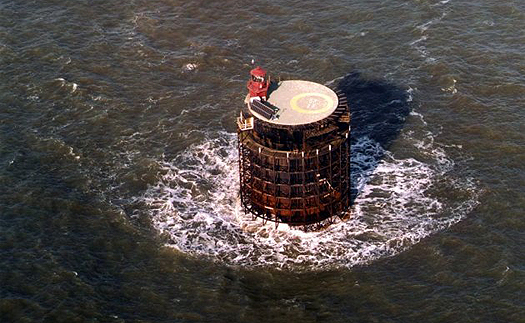
The NAB Tower
The NAB Tower is a vital aid to navigation in the Solent but the structure has been deteriorating and is being restored by Trinity House, the UK lighthouse authority. It was originally built as a British defensive structure for the Admiralty in 1918 and has been used as a lighthouse since 1920 replacing the previous NAB Lightvessel. It was staffed by Lightkeepers until automation in 1983. At present the helicopter pad atop the lighthouse cannot be used and boat access has been difficult due to the deteriorating condition of the external superstructure. Trinity House is to extend the lifespan of the NAB Tower by up to 50 years. The height will be reduced and all external steel and cladding will be replaced by concrete. Work is scheduled to be completed in the summer of next year. It will be suspended during the winter due to difficult seasonal conditions.
YOLING IN GALWAY
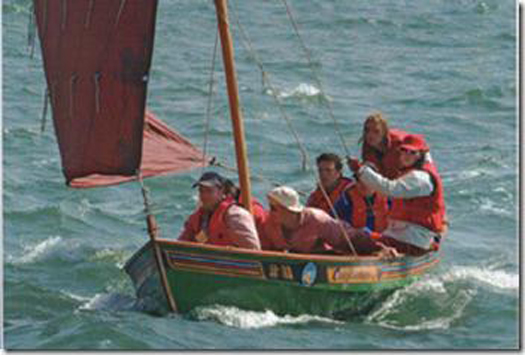
The Ness Yoal
The little beauty pictured here visited Galway Bay Sailing Club from France, but originated in Norway, were exported to the Shetlands and are now active in France, demonstrating the great linkage internationally through traditional sailing boats. The 'Yoling Club Peillac' is based in the village of Peillac, in South-East Brittany. It was created to promote traditional sailing amongst youth and especially the practice of navigation on the Ness Yoals, following the construction of three of these boats in 2000. The club aims to connect with other associations sharing similar interests in 'sail and oar' boats and to encourage the construction of traditional yachts and organises events to promote cultural heritage related to traditional sailing.
Ness yoals are wooden open boats of 6.90 m in length, rigged with a sail to the third of mahogany colour. The crew is composed of 7 people (six rowers and a coxswain). The Ness Yoals originated in Norway hundreds of years ago and were exported to the Shetland islands in Scotland, where it has a special place in the history of inshore fishing. It was considered a very seaworthy vessel and the seamanship of the men who crewed them, made the
difference between survival and starvation for many families there. Despite the development of commercial fishing, which favoured larger-decked boats, the Yoal has survived into the 21st century, due to the interest in Yoal-rowing as a sport and the craftsmanship of boat-builders like Tommy Isbister and Ian Best who still produce these craft.
UK POLITICIANS BACK SAIL TRAINING
Renowned naval architect Colin Mudie has designed a proposed new UK sail training flagship. Riding on the tide of successfully staging the Olympics and the Diamond Jubilee celebration a charitable trust has been set up called – UK Flagship – to promote the concept of a 650-foot tall ship which would be the largest and most advanced square-rigged vessel in the world. It is envisaged as a sail training ship with the additional role of being a 'floating ambassador' for the UK promoting trade and scientific research, with facilities aboard including conference rooms, oceanography and marine biological study resources and could carry up to 200 trainees. The cost is put at stg£80m., to be raised without State support. Launch of the ship is targeted for 2016 and stg£15m. has already been raised according to the backers, of which the Principal Trustee is Royal Navy Rear Admiral David Bawtree. UK sailing journalist Libby Purves is also involved in the project. The Daily Mail
Newspaper has launched a fundraising campaign for the vessel.
While not allocating any funding, leading UK politicians have pledged support and backed the project, showing at least an interest in sail training which their Irish counterparts lack. Deputy UK Prime Minister Nick Clegg said the project provided "a brilliant opportunity to promote the marine world and life at sea" while the UK Labour Party Leader, Ed Milliband, said it was a cause which deserved support because of its aim of "giving opportunity to youth."
The tall ship will feature four masts acting also as solar panels. Colin Mudie designed the sail training ships Royalist and Lord Nelson.
Operating tall ships is difficult in current economic times although the South African Government approved the conversion of a former research vessel by the country's Maritime Safety Authority to carry 50 cadets for sea training. The country has less than 2,400 seafarers and the government has adopted a policy to increase annual officer cadet intake for training which at present is 120 per year.
MAYO SAILING CLUB
When in Mulrany, Co.Mayo, this summer I enjoyed the idyllic view of Clew Bay and the 365 islands, one for each day of the year as local people proudly claim. Mayo Sailing Club was founded in 1982 and has this area as its immediate sailing grounds.
This is a thriving vibrant club, based at Westport, with a diverse range of sailing activities throughout the season - cruiser racing on Thursday nights, junior and senior dinghy racing on Tuesdays and cruising voyages.
Thirty-six trainee sailors from the club had an overnight sailing trip from Rosmoney Pier to Inishoo Island in Clew bay. It concluded the Adventure Module of the ISA Small Boat Sailing Scheme and also marked the end of the Junior Sailing course. The return voyage involved the trainees sailing a challenging beat home on a route through around many of the islands before arriving at Mayo Sailing Club.
FISHING LEADER HONOURED
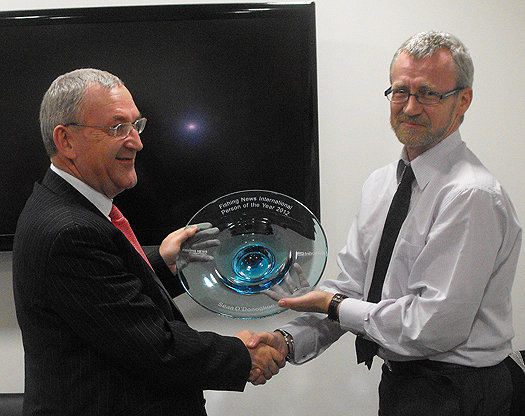
In London this week Sean O'Donoghue CEO of the Killybegs Fishermen's Organisation was presented with the Fishing News International magazine's Person of the Year award. The presentation was made by IntraFish Fishing Publications Editor Cormac Burke who is originally from Killybegs.
Rambler Crew Thankful, A Story of Two Vessels, Our Paralympians and Cork's New Pilot Boat
The Rambler Crew thank Valentia Radio for saving their lives in the Fastnet Race, but Coast Guard management wants to shut the station .... My story of two vessels ... John Twomey's Parlaympian achievements ... Cork gets a new Pilot Boat and ... trying to make ship-boarding pilot ladders safer ... There's a lot about boats in this week's TIN ..... Read on ....
SAVING LIVES MATTERS MOST – NOT FINANCIAL CUTBACKS
August 15 this year marked a very special day for the crew of the yacht Rambler 100 – they were still alive and they celebrated that fact – and they sent from New York an Email to the staff of Valentia Radio Coastal Station in Kerry. Coast Guard management in Dublin has a proposal to shut down the station and transfer its work to Dublin, to the constituency of the Minister for Transport, as a support station to the main Dublin base!
On August 15 the Rambler 100 crew Emailed to the staff at Valentia Island Maritime Radio Station:
"Today marks the one-year anniversary of our unfortunate accident during the Fastnet Race. Each Rambler crew member has his own story of what happened during this time of distress, however, the one thing that we share is the gratitude we feel for the Valentia Island Coast Guard. The professionalism of the Valentia crew and the diligence in alerting all authorities for our successful rescue is the reason we are here to share in the celebration of survival today. Tonight at 5.42 p.m. New York time the Rambler team will gather together and raise our glass to the sea and send out our thanks to our new friends in Ireland. Gratefully yours, Wendy, George and the Rambler 100 Crew."
Not much more needs to be said about the importance of Valentia Island Coastal Radio Station and its continued operation. It has a long history of saving life at sea in addition to its other operations.
I have asked for an interview with the Director of the Coast Guard Chris Reynolds, to find out exactly what is going on with the management proposals and why they want to centralise operations in Dublin. One proposal is that a support base to the national centre in Dublin should be located Blanchardstown, which just happens to be in the constituency of Minister for Transport Leo Varadakar who will have the final decision to make on the future of the coastal radio stations at Valentia and Malin and who has already indicated that "tough" decisions will be taken.
Again, the question has to be raised, as it was when then Minister Dempsey sought to close Waterford SAR rescue station – How much is a life worth?
TWO BOATS – TWO STORIES
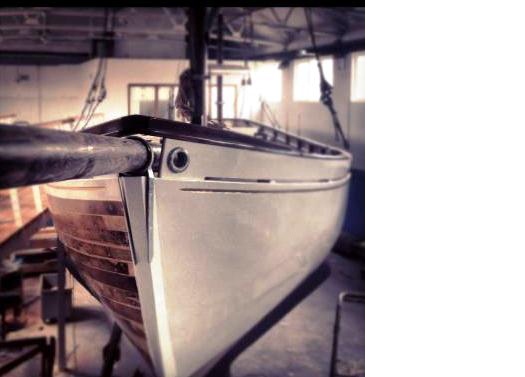
Asgard I pictured above, Celtic Mist in main image
Two boats, part of the Irish maritime scene in years past, are back in public – Asgard 1 and Celtic Mist – one ashore, the other afloat.
I was in the National Museum at Collins Barracks in Dublin when the historic ketch of Erskine and Mollie Childers went on exhibition after a five-year restoration project. It will be a permanent reminder of how the marine sphere was central to the formation of this Republic. Asgard looks superb. There was a lot of controversy over whether she should be restored or put to sea again, but the right decision has been made to conserve her ashore. The exhibition is open free-of-charge and worth seeing.
The second vessel, Celtic Mist, is the motor-sailing ketch of Charlie Haughey which his family donated to the Irish Whale and Dolphin Group. I was asked to re-dedicate it to its new role as a research vessel and did so on Sunday at Kilrush Marina, where hundreds watched the ceremony. I talked to Conor Haughey who told me: "They have rejuvenated her. She was getting old and tired and it would have been a shame if she rotted away rather than going to sea again. The boat was very important to my father. It has great family memories."
Onboard, Charles Haughey's cabin has been dismantled, including the bath and double berth and several bunks built instead for researchers who will track whales and dolphins and carry out other maritime research. Much of the eight-month refurbishment work was done by IWDG volunteers, with some contractors and financial assistance from the Clare Leader organisation and other supporters.
Despite all the controversy surrounding Haughey, as IWDG Director Simon Berrow said, getting the boat was a major benefit and came in the 21st year of its existence. In government Haughey had declared Ireland's waters a whale and dolphin sanctuary and Dr.Berrow said this should be followed by a
similar "pan-European designation" of EU waters. The Celtic Mist will provide a platform for finding out more about whales and other marine life off Ireland, he said.
JOHN TWOMEY AND THE IRISH PARALYMPIAN SAILORS
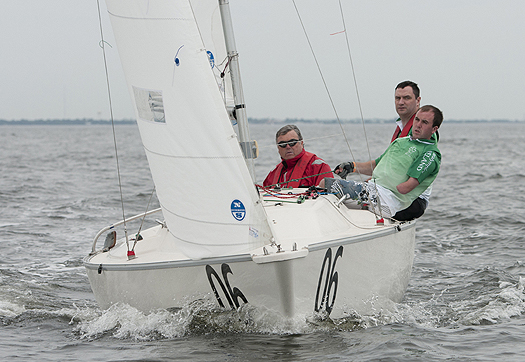
Irish Sonar Team
Kinsale Yacht Club member John Twomey is leading his crew into his tenth consecutive Paralympics, a magnificent achievement for the 57-year-old sailor. He will Skipper the Sonar, Ireland's only sailing entry, with crew Anthony Hegarty and Ian Costelloe. Sailing will be in the testing waters of Weymouth Bay on the south coast of England where the Olympic events were also held.
For the past three and a half decades he has been one of Ireland's most consistent and successful performers at the Paralympic Games. John is already the holder of Paralympic medals, won prior to his sailing career in the discus event - bronze in 1984 and gold at Seoul 1988. He also competed in table tennis before his transition to sailing, winning silver in the team event at Arnhem in 1980. Before moving to the three-man Sonar keelboat he sailed with Amy Kelleher in the mixed SKUD18 event at Beijing 2008, finishing tenth with a score of 75 points.
In preparing for this year's Paralympic John, Anthony and Ian were 7th in the World Disabled Sailing Championships in Florida and have been practising intensively off Kinsale over the past few weeks.
I met him at Kinsale YC and he was hopeful about their prospects:
"Tough waters in Weymouth, but with the experience of the past few months, particularly in the world championships we are well prepared."
John is from Ballinhassig, has represented Ireland more times than any other Olympic or Paralympic athlete. He is involved in sailing courses in Kinsale for people with disabilities where up to 30 sailors with a wide range of physical, intellectual and sensory disabilities go sailing every Saturday.
In Paralympic Sailing, three medal events feature one, two and three sailors per boat, respectively. All events consist of nine separate races with one point for first, two for second and so on, the same as in Olympic sailing. The winner has the lowest points total at the end of the nine races.
John's crew mates are 42-year-old Anthony from Mallow and 24-year-old Ian from Killorglin in County Kerry. Both are both amputees. John introduced Anthony to sailing seven years ago. He works as a software developer for Core International and has represented Ireland on several occasions. He is also a member of Kinsale Yacht Club.
Ian also sails out of Kinsale YC and will be making his first appearance at the Paralympic Games.
Paralympics Ireland CEO and Chef de Mission for the Irish Team, Liam Harbison, said there has been tremendous preparation, co-ordination and management of the Irish Team. "It's time for us to make a return on the faith and investment placed in us – we aim to deliver."

From left: John Twomey, Ian Costelloe and Anthony Hegarty.
NEW PILOT BOAT IN CORK
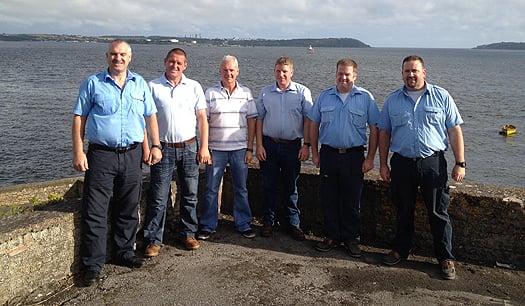
Cork Pilot Boat Crew
Cork Port has a new pilot boat. 'Failte' was built by Safehaven Marine and replaces 'Sonia' which has been in service for 14 years. Safehaven Marine is a Cork -based company, employing 25 staff in Little Island and Youghal. Since the company was founded in 1998. They have supplied pilot boats to countries from Scandinavia to the Middle East and are one of Europe's leading manufacturers of GRP pilot boat.
There are eight full-time crew, six of them pictured here – L to R: Ron Randalls, Carl Randalls, Gerry Moran, George Norris, Con Crowley and Keith Ryan. (Two were on holiday when the photo was taken.) The boat is an Interceptor 48 with two Volvo D13 engines, 600 hp each.
Cork pilot boats undertake in excess of 3,000 services per annum to vessels of all types including cruise ships and cargo vessels, according to the port company.
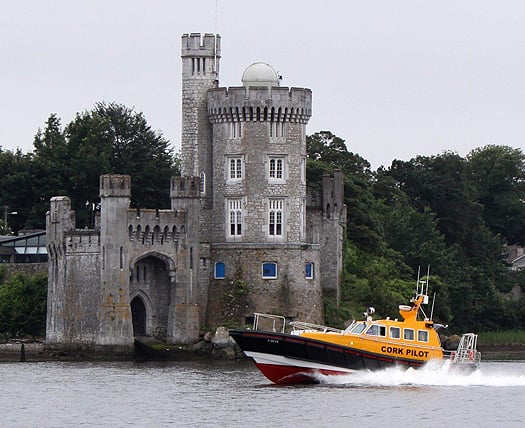
MAKING PILOTING SAFER
The International Maritime Pilots' Association and the International Chamber of Shipping have joined forces to update a brochure aimed at shipping companies and seafarers to ensure that ladders used for pilot transfers are safe and always rigged correctly.
The revised brochure – 'Shipping Industry Guidance on Pilot Transfer Arrangements' – is supported by a wide range of other international shipping bodies. It takes account of the latest amendments to the Safety of Life at Sea Convention (SOLAS) concerning pilot ladders, which came into effect on 1 July 2012.
IMPA Secretary General, Nick Cutmore, said: "Pilots continue to lose their lives as a result of accidents while boarding or disembarking from ships, and many more have been seriously injured."
ICS Secretary General, Peter Hinchliffe, added: "Some common causes of accidents still appear to be defects in the structure of the ladder treads or ropes, or a lack of a proper securing of the ladder to the ship."
An electronic copy of the IMPA/ICS brochure can be downloaded from the IMPA and ICS websites.
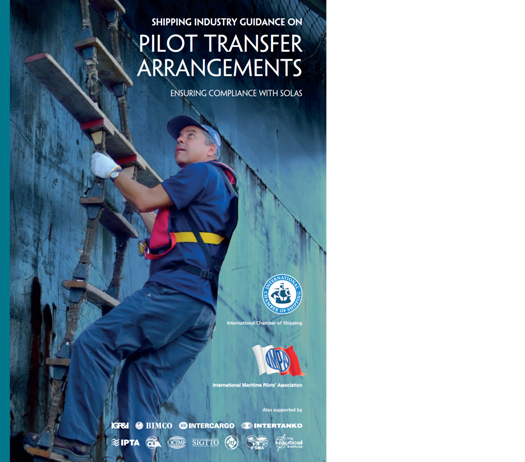
New Pilot Boarding Advice
--------------------------------------------------------------------------------------------------------
Email your comments on items in TIN develop maritime discussion to: [email protected]
Follow me for more maritime news and comment on Twitter: @TomMacSweeney
And on Facebook – THIS ISLAND NATION page
Magnificent Asgard, Commercial Fishermen and a Sticky Situation
ASGARD rises again .. Can you help to find goose barnacles? ... Irish brothers wrap up the 18s in Scotland... Commercial fishermen want bass fisheries re-opened.... The weather hasn't really been so bad – do you believe that? The Channel Tunnel buys ferries ... Lusitania artefacts are assigned to the States and the oceans are saving humans ashore. That is the TIN mix this week.... Read on ....
ASGARD IS MAGNIFICENT
I have reported the conservation of Asgard since it began five years ago under the leadership of John Kearon from Arklow who formerly headed up restoration work at Liverpool Maritime Museum where I saw him direct the refurbishment of the Wolfe Tone Bantry Longboat. Both are now on public display at the National Museum in Collins Barracks, Dublin. Asgard looks magnificent, painted on the port side, the varnished hull gleaming on starboard. Standing under the port side at the opening ceremony as she went on public exhibition, I remembered how she had looked when I first saw her, raw, much in need of attention so many years back when John told me with confidence that she would be restored to what she had originally looked like. There was painstaking tracing of artefacts, of locating many items which had been removed from the vessel in previous years. There was a lot of controversy and opposition to the restoration from those who wanted her to go afloat again. They opposed the concept of a vessel being preserved ashore, out of her natural environment. There is no doubt in my mind that the correct decision was taken, to make her a national treasure, on display, open for viewing free-of-charge to the public, a reminder of the birth of our nation and her pivotal role in the 1914 Howth gun-running from which weapons unloaded were later used in the Easter Rising. She will also be remembered as Ireland's first national sail-training vessel. All those memories flowed from the large attendance present when she went on display. I met many friends from the maritime sphere. A common comment was the regret that there is not an Asgard 3 to carry on the great tradition of this name in Irish sail training. The former government and Minister responsible at the time, Willie O'Dea, destroyed Irish sail training, a denial of Ireland's maritime role and of the educational and cultural, formative role of young people through the sea. Is there anyone, any wealthy Irish businessman or business group, who would provide the funding for an Irish sail training vessel. It would have been possible to purchase a new vessel for the €3.8m. compensation paid for the sinking of Asgard 2 but Willie O'Dea handed over that money to the Department of Finance, a blow against Ireland's maritime sphere.
COMMERCIAL FISHERMEN WANT BASS FISHERIES OPENED
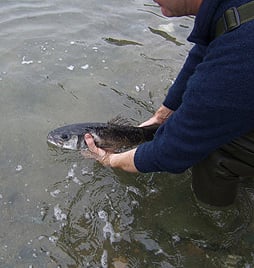 The Irish Fishermen's Organisation has called on Marine Minister Simon Coveney to re-open bass fisheries to commercial fishermen. They have been closed for several years but that may lead to Ireland being excluded forever from fishing bass, while foreign vessels in the EU can catch the fish in Irish waters. The EU has begun a process to put controls on the catching of bass by commercial boats, known as the TAC - Total Allowable Catch. Officials have proposed that this be based on commercial landings of bass over a ten-year period. But Ireland will have no adequate record to claim part of this TAC, so once again the Irish government approach will damage the Irish fishing industry and allow foreign nations to continue catching in Irish waters, while Irish boats cannot. The leisure angling industry demanded and got the ban and has benefited from non-commercial catches. While Irish fishermen are banned from catching bass, foreign boats have targeted the species off the South coast and will be allowed continue, even if a TAC is imposed because they have a catching record. "The Irish Government is again handing national resources to foreign usage," said the commercial fishermen's organisation. Anglers are only allowed to have two bass in their possession in any one 24-hour period and they must be over 40 cm. in total length.
The Irish Fishermen's Organisation has called on Marine Minister Simon Coveney to re-open bass fisheries to commercial fishermen. They have been closed for several years but that may lead to Ireland being excluded forever from fishing bass, while foreign vessels in the EU can catch the fish in Irish waters. The EU has begun a process to put controls on the catching of bass by commercial boats, known as the TAC - Total Allowable Catch. Officials have proposed that this be based on commercial landings of bass over a ten-year period. But Ireland will have no adequate record to claim part of this TAC, so once again the Irish government approach will damage the Irish fishing industry and allow foreign nations to continue catching in Irish waters, while Irish boats cannot. The leisure angling industry demanded and got the ban and has benefited from non-commercial catches. While Irish fishermen are banned from catching bass, foreign boats have targeted the species off the South coast and will be allowed continue, even if a TAC is imposed because they have a catching record. "The Irish Government is again handing national resources to foreign usage," said the commercial fishermen's organisation. Anglers are only allowed to have two bass in their possession in any one 24-hour period and they must be over 40 cm. in total length.
CAN YOU HELP RESOLVE A STICKY SITUATION?
Humans have not managed to create glues that can be used successfully in wet environments, but sea creatures have and Irish marine researchers are trying to find out how they do it. The secrets of the goose barnacle are being sought so that a synthetic version of their natural underwater glue could be used in surgery and dentistry. This barnacle is mostly at sea so examples are difficult to find ashore. Although goose barnacles look like giant shellfish attached to a long neck, they are in fact filter-feeding creatures.They have an ability to attach themselves to practically every surface and researchers have found they can even do so to non-stick frying pans! The glue-like substance they emit, which hardens into a strong "cement", consists of several proteins. Scientists based at the Martin Ryan Marine Institute in Galway hope to study the glands emitting the glue and the protein composition. The team needs a large supply of goose barnacles and has asked for public help from people on the beaches, swimming, surfing and from divers. The barnacles sporadically wash ashore in Summer along the Irish coast. "It might seem perfectly ordinary that a sea creature can stick to a surface, but if you stop to think about it, it's actually quite an incredible innovation by nature," say the researchers. "Humans haven't managed to create glues that can be used successfully in wet environments, but nature has done it over and over again."
TUNNEL BUYS FERRIES – UK GOVERNMENT WANTS TO KNOW WHY
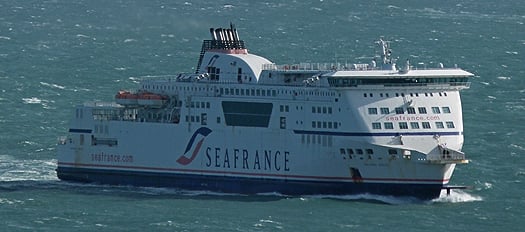
Eurotunnel, the company which operates the Channel Tunnel, has bought three of SeaFrance's former vessels. The move surprised the UK Government where the Office of Fair Trading has launched an investigation to decide whether the purchase is in contravention of merger rules. Eurotunnel Chief Executive Officer Jacques Gounon Jacques Gounon said: "There's an evolution in traffic, notably towards heavy goods vehicles, which can't be fully captured by the Channel Tunnel."
CORK BROTHERS WRAP UP THE 18S IN SCOTLAND
Cork Harbour Monkstown Bay Sailing Club members, brothers Ewen and Colin Barry won nine of the ten trophies up for competition at the National 18 Class Championships in Findhorn in Scotland, a stunning achievement.
Colin is the Club's Rear Commodore and Ewen is Hon.Treasurer. Another MBSC member, Dave O'Connell, a long-time stalwart of the Class was fifth overall in a fleet which included entries from the Scottish host club, from Temasis Yacht Club in London, the Isle of Man YC and the Royal Cork.
Ewen and his crew were sailing 'Good Bad & Ugly' and were top overall boat on nine points, six clear of brother Colin and his crew sailing 'Purple Warriors' on 13 points in second place. They finished on the same number of points as Colin Chapman from the RCYC. A tie-breaker, used in sailing to establish final positions from the best individual race placings, favoured the Monkstown crew. The National 18-foot dinghy has survived several assaults on its popularity, one of which was from the development of the 1720 Class, named after the founding year of the Royal Cork and which it was once thought would replace the 18. That did not happen and, after a surge of popularity, the 1720 declined for a number of years locally though gaining a lot of support internationally. It is now regaining popularity as a sportsboat.
STATE GETS LUSITANIA ITEMS
Items recovered from the last survey of the wreck of the Lusitania have undergone conservation and maintenance in Ireland and been assigned to the State. They include part of the steering mechanism, a bronze telemotor, four portholes, two of them from the first-class passenger area and an indicator used for finding the ship's direction. The items were recovered during the filming of the recently-transmitted National Geographic Channel television documentary. The company sponsored the last survey carried out a year ago.
There have been legal disagreements between American millionaire Greg Bemis who owns the wreck and the State, but there were negotiations involving the National Museum, the National Monuments Service and his representatives after the survey in which Irish maritime archaeologists were involved.
A BAD SUMMER - BUT IT COULD BE WORSE!
It has been a bad summer but history shows that there have been much worse! 1783 for example when there was so much volcanic activity around the world and a fog that lasted most of the summer in England, leading to predictions that it was the end of the world! Between June 23 and July 20 of that year the skies over the UK were covered by a smoky fog and there was regular thunder and lightning which terrified people. There were volcanic eruptions in Italy and Japan and a massive eruption on Skaptar Jokull in Iceland where 9,500 people were reported to have died after being smothered by the immense dust cloud which drifted south and covered much of Europe.
Remember the last Icelandic cloud?
OCEANS ARE SAVING US
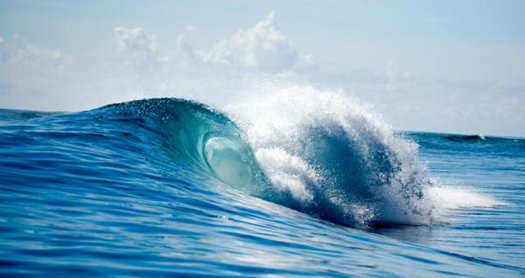
If the oceans were not soaking up carbon dioxide from land, global warming would be much worse. A new report this week shows that industrial production and human living requirements on land are now creating so much carbon dioxide in the atmosphere that the oceans and plants ashore are having to absorb more than twice the amount they previously soaked up. They are the only brake on global warming, but having to absorb so much CO2 is changing seawater, a process called ocean acidification. "This change will have profound effects on life in the ocean and those who depend on it," according to the report from the University of Colorado in the USA which confirms data from the Global Carbon Project, linking scientists around the world. Carbon soaked up from the atmosphere by the seas has risen to 5 billion tonnes. Twenty years ago the figure was 2.4 billion.
Email comments, opinions, information to: [email protected] more marine news and comment on Twitter: @TomMacSweeney
And on Facebook – THIS ISLAND NATION page
Valentia Radio, Coastguard Equipment & Poor Olympic Coverage
Another attempt is being made by Coast Guard management in Dublin to close the coastal radio stations at Valentia and Malin Head and centralise operations in Dublin. That, the poor quality of television coverage of sailing at the Olympics, the future of the State's national fishing board and the launch of the national maritime plan, are amongst my topics on this week's THIS ISLAND NATION.
RESPECT FOR VALENTIA RADIO
Sailing the West Cork coastline last week Valentia Radio was a welcome companion. I listened to their regular sea area weather forecasts on VHF. They also provide the added service of message 'traffic' for vessels at sea, and advisory warnings about hazards, amongst their service. In addition to VHF Medium Frequency transmission covers a wider maritime area. The voices of the station staff become a familiar and welcome part of one's voyaging. You know they are there, a source of help and support if needed. During the week I heard them involved in search and rescue work, using their local knowledge.
On the North-Western coastline they are partnered by Malin Head Radio, providing a similar service. The staff of both have that vital component not available anywhere else, of local knowledge of their sea areas. The central base is in Dublin where staff can concentrate on the East Coast.
The service works well but high-level Coast Guard officials have been attempting for several years to centralise operations in Dublin and close Valentia and Malin. Previous attempts to do this were defeated when Coast Guard Management proposals were shown not to be in the best public interest.
I feel a sense of anger and annoyance that another attempt is being made to target the stations, emanating from the Department of Transport where a reliable source has given me details of a study on which Minister Leo Varadkar has told officials to prepare proposals which will propose what are termed 'hard decisions' before the Cabinet in October. It appears to me that Coast Guard management want one station, in Dublin, to control all output and, I am told, have repeatedly sought the adjustment of consultant reports to achieve this end. It could be done technically, but would exclude the vital aspect of local sea area knowledge which, in both Valentia and Malin has several times saved lives. It is an approach to safety which is not acceptable, with which there should be no compromise. When then Minister Noel Dempsey attempted to close the helicopter base at Waterford I raised the question – what is the value of one life? I do so again now.
NEW STATION EQUIPMENT
New equipment assigned to upgrade Valentia after the last controversy in 2009 is only due to be installed this month or next, a wait of three years!
New equipment is also being installed at present in Malin. One of the proposals by Coast Guard officials is that if a second station is needed to back-up and support the Dublin central base in case of any fault developing there and threatening a blacking-out coastal communications it should be in Blanchardstown, which just happens to be the Minister's constituency!
A new engine room, new boiler room, new security system, new generator, new operations room, an upgraded transmitter room and a helipad are due for installation in Valentia, so where is the justification for now considering closure – and at a time when other general Coast Guard stations, not radio stations, are and have been built around the country at considerable expense? Where is the logic in this?
THIRD LARGEST COASTAL STATION
Valentia is the third largest coastal marine station in Ireland and the UK. It covers the most turbulent seas in Western Europe and the roughest inland terrain in the country, where it also helps with search and rescue and deals with two-thirds of all 'Mayday' emergency calls around the coast of Ireland.
The station employs 16 people.
At present the Departmental-Coast Guard budget is putting money into a move away from the Eircom fixed line network to an independent contracted microwave network, configured to enable the coast to be covered effectively for marine radio, search and rescue, assistance information by three stations. If this was to be changed to any other configuration, if a one-centre option is chosen in Dublin, there would be an extra cost of around €10m. I have been told. Adding the €5m. already spent on the government decision to improve Valentia and Malin, I wonder what the point of all of this is? Why is Coast Guard management opposed to the costal-based marine radio stations, at the same time as building other Coast Guard bases around the coast. There seems a lack of logic in this approach.
WHAT IS THE VALUE OF A LIFE ?
In safety-at-sea terms the present maritime coastal radio station configuration of Valentia and Malin will always be required, as long-range Medium Frequency communications will stay there, used in addition to VHF to cover wider areas of reception. So even if a one-centre manned set up was followed, with an unmanned centre duplicate in case of Dublin breakdown, there would be two additional unmanned sites at Valentia and Malin to be maintained for long-range communications with attendant costs.
Dublin operates three 8-hour watches while Malin and Valentia have operated a 12-hour shift pattern with the effective saving of 2 staff positions without the requirement for overtime.
Coast Guard officials and the Minister for Transport should back away from proposals to do anything which would reduce the effectiveness of safety at sea.
They would be well advised to do so.
THE FUTURE OF BORD IASCAIGH MHARA
The Chief Executive of the national fisheries board, Bord Iascaigh Mhara, has told me that: "If you look at where the economy is at now, the need for a standalone agency dealing with seafood development makes sense more than at any time in our economic development. The case is stronger today than it has been for many a long time."
Jason Whooley was speaking to me about suggestions that BIM should be abolished and its functions absorbed elsewhere:
"I hope and would expect the review of BIM will come to the conclusion that it is vital to the seafood sector, to the fishing industry, to maintain BIM, but equally it is up to us as an organisation to constantly review ourselves and our services and deliver for the industry. People may see us as a State agency, cushioned from the wider economy and that an organisation needs a jolt. Perhaps that keeps us on our toes, because we are looking at ourselves constantly to improve our services, so I do think BIM has a strong future."
Closing BIM would, in my view, indicate disregard for the role of the marine sphere in government. The opinions of economic consultants are too easily accepted without challenging the damage they could do to the nation's future.
NATIONAL MARINE PLAN
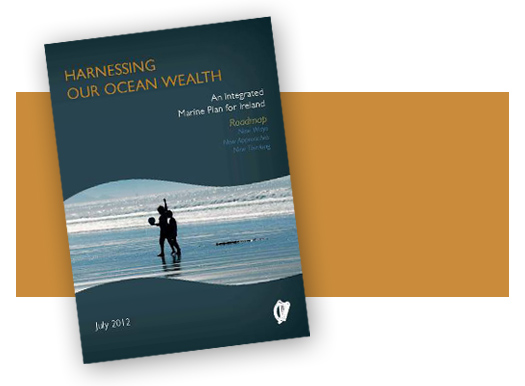
"For too long we have turned our backs on the sea. It's time now to look to our ocean as a national asset, to harness the opportunities for economic recovery. We need to treasure what we have and protect it for future generations. We also need to build on the potential of our ocean wealth and what it can give back to its people. 'Harnessing Our Ocean Wealth,' the title of this plan, puts a structure in place to make that happen".
That was the opinion expressed by Marine Minister Simon Coveney when he launched the national maritime development plan with the Taoiseach in Galway. It proposes that the value of Ireland's ocean wealth could be doubled to 2.4% of GDP and the turnover from our ocean economy be increased to more than €6.4bn by 2020.
It is a long-term outlook, but one to focus on, for seafood, fishing, marine tourism, shipping, oil and gas, renewable ocean energy and new applications for health, medicine and technology. It sets out goals to achieve a thriving maritime economy, healthy ecosystems and to increase the nation's engagement with the sea, focussing on the State creating the right conditions to promote investment and enable growth.
POOR OLYMPIC COVERAGE
I have had quite a few calls and Emails complaining about television coverage of sailing at the Olympics. It has been poor. TV coverage for the Games is provided by t Olympic Broadcast Services (OBS), an agency of the International Olympic Committee and prevents other broadcasters from covering the events. In sailing coverage has not been satisfactory and at times is done on a single camera which is not acceptable at this level of the sport. The IOC has treated sailing badly in television coverage. For a link to all the latest Irish Olympic sailing news click here.
• Email comments, opinions, information to: [email protected]
Follow more marine news and comment on Twitter: @TomMacSweeney
• And on Facebook – THIS ISLAND NATION
Six Thousand Milk Bottles, Barryroe Oil Progress & What Ships Might Look Like in 2020
#thisislandnation – Six thousand milk bottles in Bantry's inner harbour, Barryroe Oil progress, what will ships look like in 2020, disappearing manta rays, a new book scheme for seafarers, emotion in Union Hall, and the future of navigation and visual aids. Read on for this week's Irish and world maritime news developments.
SIX THOUSAND HARBOUR MILK BOTTLES
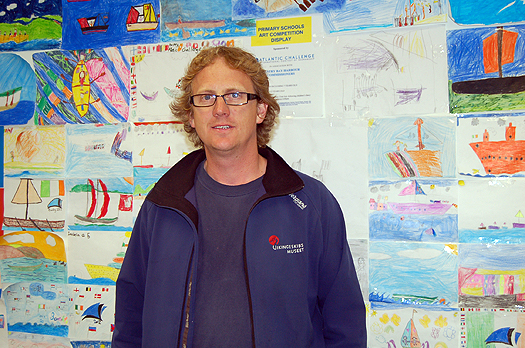
Diarmaid Murphy Bantry Atlantic Challenge organiser with schoolchildrens images of the event
The schoolchildren of Bantry created an impressive sight in the town's inner harbour where they used 6,000 two-litre milk bottles to build a replica boat for the Atlantic Challenge. Their project underlined the community-wide support for the event which brought hundreds of young sailors to the town for the past week.
Diarmaid Murphy, who led the event's organisational team, told me that the townspeople would like to see the inner harbour developed.
"It has considerable potential for marine leisure. The Challenge is a great event and we have been involved with it since 1988, so there is strong community support for what has been achieved here and the benefits the event, including taking part at home and abroad which has benefited our young people. The event also highlighted the potential of the inner harbour for the town."
The increase of interest in the Bantry Longboats which are used for the event is good to see. There are plans to build a new boat in Tullamore, so perhaps the inland waterways and the Shannon may see a longboat afloat.
BARRYROE OIL PROSPECTS
Last week I wrote about holding a vial of Barryroe Oil in my hand, pictured here and this week Provident Resources confirmed reports that the find has strong prospects. Its announcement will increase interest by the 'majors' in oil production and this is normal at this stage of the find. What benefit will Ireland get from the find? That question has been raised. The present situation is that 25 per cent of the net profits of a developed find, but note that is 'net' after exploration and development costs have been deducted, go to the State. Taxation changes could only be implemented for new investment. Don't expect, at least for the present, that Ireland is going to become as rich a country as Norway!
THE SHIP OF 2020
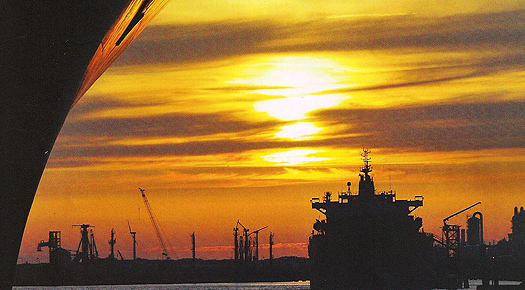
Technology has made major changes in ship design and operations, but reliance on modern electronic aids and monitoring and control systems will place extra pressure on watchkeepers who will have to avoid complacency in depending upon instrumentation and ensure that the shipboard "man-machine" interface works.
That observation is made in the International Journal of the Nautical Institute, Seaways. The Institute is the professional body for mariners. Rod Short who is Executive Secretary of GlobalMET Limited, writes: "Technological development and its impact on ship operations will continue and probably accelerate. On-board operational roles will have an increased element of systems monitoring and on-board management roles will move towards the building of leadership and teamwork, in particular developing teamwork among multi-cultural crews who may have varying standards of education and training."
He maintains that it is likely that a new ship in the 2015-2020 period will be "extensively automated with extensive use of electro-technology for all critical operations and will be more efficient, more economical and more environmentally friendly."
EMOTION IN UNION HALL
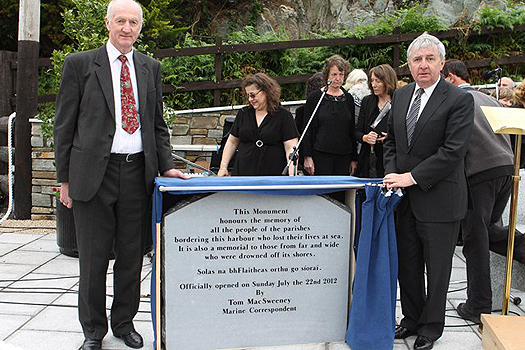
Marine correspondent Tom MacSweeney on right who unveiled the commemoration plaque and officially opened Union Hall Memorial Garden on Sunday July 22nd. On left is Mr Paddy O'Donovan, MC for the occasion and founder of the local community council.
The community of Union Hall have built an impressive memorial to the memory of seafarers at the entrance to the village which was the centre of the Tit Bonhomme trawler tragedy search last January. It is dominated by a 23ft. high anchor.
"On the plaques are recorded the drowning of 99 people, 76 who are named and the majority of whom came from three parishes around Union Hall," community leader Paddy O'Donovan told me. "The other 23 are unknown to us but would have been either Italian or English."
Some lost their lives while earning their living in fishing boats, others drowned in foreign waters in both World Wars, some were strangers whose cargo ships foundered off the coast, others drowned while engaging in watersports. The earliest tragedies recorded date back to February 1874. The memorial has been part-funded by Cork County Council, the rest raised by the community, many of whom I met, including relatives of those who died in the tragedy and the only Egyptian survivor, when I was honoured to unveil the memorial.
BOOK SCHEME FOR SEAFARERS
The Marine Society of the UK has launched a new crew book service for seafarers and ship operators. Books@Sea will equip ships with new paperbacks for seafarers. It is a new crew library service built on the experience gained by the Marine Society over many years.
"It offers a means of relaxation for seafarers and is a positive contribution to a safety culture at sea," said Captain Andy Winbow, Assistant Secretary of the International Maritime Organisation, at the launching of the service in London.
More information on: www.marine-society.org
E-NAVIGATION DEVELOPMENT
The Commissioners of Irish Lights will be working with user groups and stakeholders in the coming year to define how e-Navigation should be implemented in Ireland.
Captain Robert McCabe, Acting Head of Marine at CIL, believes that the role of visual Aids to Navigation will "undoubtedly decrease and radio navigation will come to the fore." In The Beam magazine of the Commissioners he indicates that 'Visual AtoN will still have a role 'for spatial awareness and the marking of some dangers' but they will reduce in both number and range.
"The risks of 'heads down' navigation (looking at the screen) are obvious. The challenge is to significantly improve 'heads up' navigation (looking out the window) and to continue to engage navigators with their surroundings while taking advantage of improved positioning, communications and charting. In the coming year we will work closely with user groups and stakeholders to define how e-Navigation should be implemented in Ireland and how we can maximise the benefit."
GENTLE GIANTS UNDER THREAT
The ocean's "gentle giants" as they are known, manta rays, are under threat because of increased fishing in Asian and South American waters to catch and kill them for their gills, used in soups and other dishes in Asia and traditional Chinese medicine.
The rays are pulled from the ocean, using either fine gill nets or spears. They are easy targets as they move slowly through the water. The United Nations Food and Agriculture Organisation says catches have quadrupled and the International Conservation for Nature has now classified the species as 'vulnerable.' They are in particular danger because they produce few young.
You can follow me for more marine news and comment on Afloat's Twitter and Twitter: @TomMacSweeney
And on Facebook – Afloat magazine and This Island Nation
# ISLAND NATION – The boat builder who sailed a spinnaker on the Grand Canal in Venice, the government's maritime plan, more than 1,000 salmon caught on just two Irish rivers in one week, the polluted air of Dublin Bay, fishermen frustrated over the ban on discards, deep-sea mobile stations, a US prosecution for dumping at sea and less money for scrapping ships are amongst my topics this week.
THE ACHIEVEMENTS OF KILLIAN BUSHE
There is a legendary story in sailing about the Cork yacht Silver Shamrock which won the Half Ton World Cup Championship at Trieste in Italy in 1976. The crew celebrated by sailing the boat up the Grand Canal in Venice with a spinnaker set. It was some sight and one of the crew aboard was a young Crosshaven sailor at the time making an impression in the sport. Killian Bushe added many more sailing successes to his list before moving onto building boats as well as racing them.
The Bushe family is synonymous with boat building, tracing its achievements from Baltimore in West Cork to encompass Ringaskiddy, Rochestown and Crosshaven in Cork Harbour where George Bushe was a legendary figure. His son, Killian, is now a top builder of ocean racing yachts, having been involved in building the last four successive winners of the Volvo Ocean Race.
When Damian Foxall from Kerry, helmsman, sail trimmer and crew manager of the French yacht, Groupama, which won this year's Volvo Race waved the trophy from the winners' podium to the huge crowd watching in Galway, the thought in my mind was that this was a dual Irish international success.
While Damian sailed the yacht across 39,000 miles Killian Bushe was the lead consultant for the building of Groupama. That followed his construction of the three previous Volvo Race winners – the Swedish Ericsson, the Dutch ABN Amro One and the German Illbruck. That is a tremendous record, so it surprised me that most media reports did not mention him.
He lived in Crosshaven until 1979 and has a string of international successes as a sailor to his credit from which he turned to boat building and is now resident in Ljungskile, Sweden, where he has been called on as the boat-builder of choice, favoured by leading designers and top skippers alike whenever a high-powered strongly-resourced international challenge is taking shape. That included the Swedish challenge for the Americas' Cup, Artemis.
GOVERNMENT MARITIME PLAN
Minister for the Marine Simon Coveney has indicated that the government's Marine Co-ordination Group is currently drafting the promised national maritime programme. It is due to be launched this month. It has been indicated that the Taoiseach is taking a personal interest in the programme which is described as "Actions that will deliver an integrated marine plan for Ireland." 191 submissions were made during a consultation period.
It will be interesting to see how the programme integrates State and private sector maritime activities. The State must give decisive leadership, making it clear that the marine sphere is a national priority.
LOTS OF SALMON
Salmon are back in big numbers, with well over a thousand caught in the past week. More than 800 salmon were taken on the River Moy in what Inland Fisheries Ireland, the State organisation, says was "another extraordinary week for an Irish river," reaffirming the Moy as Ireland's premier salmon fishery. Fish were taken on worm, spinner and fly, with notable captures on the fly in particular. Amongst salmon catches reported by IFI are 26 on the Ballina Salmon Anglers' water, over 40 at Mount Falcon, 32 at the Foxford Fishery.
There have also been good catches of salmon in the Limerick area, 200 caught at Ballisodare and catches on Lough Beltra, Carrowmore Lake and the River Feale.
The ban on drift-netting remains a divisive issue for coastal communities, but it seems the leisure and tourism angling sector has benefited.
FROM THE MOON TO THE SEA
The Chinese are planning to follow space stations with a nuclear-powered mobile deep-sea station where a crew of 33 will spend up to two months at a time beneath the waves. It will have huge propellers for ocean movement and its main goal will be to search for and mine precious elements.
The China Ship Scientific Research Centre has been doing test dives of manned vehicles. Its Jiaolong model reached a record-breaking 7,020 metres at the Mariana Trench in the Pacific Ocean, the deepest in the world.
DISCARDING FISH
While the public has welcomed the ban on discarding fish caught at sea, fishermen's representative organisations are critical. It seems that the umbrella organisation which represents all the groups, the Federation of Irish Fishermen, is not happy with the Marine Minister and his officials. There are allegations of lack of consultation. Fishing organisations claim they had alternative and more effective proposals and that the Minister and his officials reacted to high-profile celebrity chefs and environmental organisations.
The official view is that all catches should be landed, while fishermen say they should not be taken in the first place and that control measures should focus on that. They have described the new ban as "dumping ashore what was dumped at sea."
CAPTAIN TO BE SENTENCED
The captain of a Panama-flagged cargo ship, found guilty of obstructing a US Coast Guard inspection after allegations that he ordered the discharge of hundreds of plastic pipes into the ocean, is to be sentenced on August 15.
38-year-old Captain Prastana Taohim of the mv.Gaurav Prem was found guilty by a jury in Mobile, Alabama. The inspection took place last September.
Witnesses had testified that Captain Taohim ordered the ship's chief officer to throw hundreds of plastic pipes into the ocean and not record the discharge in the ship's garbage record book. The plastic pipes had previously contained insecticide and were used to fumigate a grain shipment. The discharge of plastic into the sea is prohibited under the International Convention to Prevent Pollution from Ships, MARPOL.
MORE SHIPS SCRAPPED FOR LESS MONEY
An increasing number of ships, particularly older ones which cost more to operate because of fuel prices, are being scrapped by the world's shipowners, but for less money. The biggest number are the Panamax vessels, the largest to transit the Panama Canal. Fifty-six of these were sold for demolition in the first half of this year, compared with 38 a year earlier.
There is an oversupply of vessels to serve declining world trade due to the current economic difficulties of many countries. Resultant unprofitable charter rates are prompting owners to demolish vessels at a record pace. Overall tonnage sold for scrapping rose 25 per cent in the first half of this year compared with last.
A 34 per cent surge in fuel prices over the past two years has spurred scrapping as older vessels tend to consume more oil than newer ones and are considered too dear to operate. But scrap prices for ships have plunged 13 per cent. Prices have also been cut by the rupee's plunge in the past year, the worst amongst Asian currencies. India vies with China as the world's largest market for shipbreaking.
DUBLIN SEA AIR
"I rolled my considerable frame off the starboard bunk, struggled to make myself half decent and dragged my protesting body up on deck for a mouthful of freshly polluted Dublin sea air."
That introduction is headed "The Sleep Beast" and begins the book which Crosshaven sailor Rom Hyde launched on Monday night in the Port of Cork offices about his sailing career. Born in February of 1947 he claims to have had his "first sailing experience in July of the same year, but I am fairly vague about it." The book is called "What's that hanging from the starboard bow?" You don't have to be a 'yachtie' to read it!
email me your comments at [email protected]
You can follow me for more marine news and comment on Twitter: @TomMacSweeney and Afloat magazine @afloatmagazine
And on Facebook – THIS ISLAND NATION page and Afloat magazine's facebook page
































